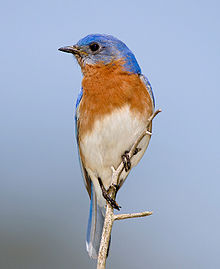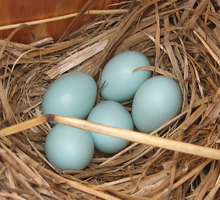- Eastern Bluebird
-
Eastern Bluebird 
A pair in Michigan, USA Conservation status Scientific classification Kingdom: Animalia Phylum: Chordata Class: Aves Order: Passeriformes Family: Turdidae Genus: Sialia Species: S. sialis Binomial name Sialia sialis
(Linnaeus, 1758)
Approximate range in North America.
Yellow = summer only
Blue = wintering only
Green = all yearThe Eastern Bluebird, Sialia sialis, is a small thrush found in open woodlands, farmlands and orchards, and most recently can be spotted in suburban areas. It is the state bird of Missouri[1] and New York.
Adult males are bright blue on top and have a reddish brown throat and breast. Adult females have lighter blue wings and tail, a brownish throat and breast and a grey crown and back. Eastern Bluebirds are found east of the Rockies, southern Canada to the Gulf States and southeastern Arizona to Nicaragua.
The bright blue breeding plumage of the male, easily observed on a wire or open perch, fluttering down to the mowed grass to capture a grasshopper, cricket or beetle makes this species a favorite of birders. The male's call includes sometimes soft warbles of jeew or chir-wi or the melodious song chiti WEEW wewidoo (Sibley, 2000).
Contents
Food
Approximately two-thirds of the diet of an adult eastern bluebird consists of insects and other invertebrates. The remainder of the bird's diet is made up of wild fruits. Favored insect foods include grasshoppers, crickets, katydids, and beetles. Other food items include earthworms, spiders, millipedes, centipedes, sow bugs, and snails.
Fruits are especially important when insects are scarce in the winter months. Some preferred winter food sources include dogwood, hawthorn, wild grape, and sumac and hackberry seeds. Supplemental fruits eaten include blackberries, bayberries, fruit of honeysuckle, Virginia creeper, Eastern Juniper, and pokeberries. Bluebirds feed by perching on a high point, such as a branch or fence post, and swooping down to catch insects on or near the ground. The availability of a winter food source will often determine whether or not a bird will migrate. If bluebirds do remain in a region for the winter, they will group and seek cover in heavy thickets, orchards, or other areas in which adequate food and cover resources are available. If you want to attract these species, put crunched-up peanuts in a feeder about four feet off the ground.
Habitat
Eastern bluebirds prefer to nest in woodlands where cavity holes excavated by a previous species will serve as their home. These woodlands must be near clearings or meadows because this is the preferred hunting ground of the species. River or creek access is an added benefit and preferred. Keep these things in mind when placing a nestbox in your backyard.
Similar species
- Western Bluebird (Sialia mexicana)
- Mountain Bluebird (Sialia currucoides)
References
- BirdLife International (2004). Sialia sialis. 2006. IUCN Red List of Threatened Species. IUCN 2006. www.iucnredlist.org. Retrieved on 6 May 2006. Database entry includes justification for why this species is of least concern
External links
 Data related to Sialia sialis at Wikispecies
Data related to Sialia sialis at Wikispecies  Media related to Sialia sialis at Wikimedia Commons
Media related to Sialia sialis at Wikimedia Commons- North American Bluebird Society
- Life Histories of Familiar North American Birds: Eastern Bluebird.
- Bird Life International: Eastern Bluebird - Species Factsheet.
- South Dakota Birds - Eastern Bluebird Information and Photos
- Cornell Lab or Ornithology, Eastern Bluebird Identification
- Eastern Bluebird Species Information from Bluebird Information and Awareness
- National Geographic News article Covers N.A. Breeding Bird Survey, birdhouses, bluebird recovery
- [1]
- Eastern Bluebird Bird Sound
- Bermuda Department of Conservation Services Bluebird Page
Categories:- IUCN Red List least concern species
- Bluebirds
- United States state birds
- Birds of Bermuda
- Birds of Guatemala
- Birds of Honduras
- Birds of Mexico
- Birds of the United States
Wikimedia Foundation. 2010.



